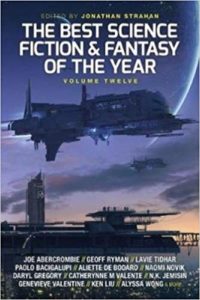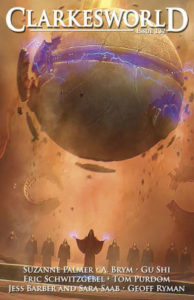Jonathan Strahan continues to deliver one of the top science fiction anthologies with the latest version of The Best Science Fiction & Fantasy of the Year, Volume 12 (published April 17, 2018 by Solaris).
 We’ve selected and reviewed a few favorite short stories and novellas from among the nearly 30 featured in this anthology, all of which were published during 2017, primarily in online and print magazines. Although the stories range significantly in subject matter and style, a few themes recur in multiple entries — including the threat of AI, survival in a resource-constrained world, and the dominance of social currency.
We’ve selected and reviewed a few favorite short stories and novellas from among the nearly 30 featured in this anthology, all of which were published during 2017, primarily in online and print magazines. Although the stories range significantly in subject matter and style, a few themes recur in multiple entries — including the threat of AI, survival in a resource-constrained world, and the dominance of social currency.
In “Martian Obelisk,” Linda Nagata writes a beautiful, bleak story about Susannah Li-Langford’s attempt to create something lasting as humanity’s chances for survival dwindle. What distinguishes “Obelisk” from other end-of-the-world stories are the lack of one catastrophic event leading to humanity’s decline and the necessity of hope to survival. Nagata realistically portrays a near future in which a myriad of problems (disease, overpopulation) have stacked up against humanity, and civilization has passed a tipping point, with our best days behind us. The eponymous tower Susannah builds using remotely controlled machines is an attempt to find some meaning in her existence. The final moments of the story bring some glimmer of hope. 
In “Carnival Nine,” Caroline M. Yoachim creates a fairly detailed world populated by windup dolls with a lifespan limited by the number of turns their mainspring can hold. The main character, Zee, sacrifices much of her life and “turns” to care for her son, who suffers from a defective mainspring that can’t hold more than a few turns at a time, significantly limiting his mobility. Zee’s story serves as a metaphor for a mother’s sacrifice. The completeness of the world in which the story is set and the simplicity of the central conceit give “Carnival” poignancy and emotional weight.
“Eminence” by Karl Schroeder is one of a few stories in this anthology focusing on a near-future (perhaps non-fictional) world in which capitalism becomes increasingly distorted by alternative currencies. The story focuses on Gwaiicoin, a cryptocurrency based on the value of the backer’s ecosystem. Most of the plot deals with Nathan trying to salvage his investors’ money in connection with one of his failed schemes in a rigged system. Visualizations of Gwaiicon blockchains as a kind of augmented reality display showing the movement of wealth are among the most powerful moments in the story: “Compared to the dizzying complexity at street level, there were very, very few names up there at the top.”
 In “Sidewalks” by Maureen McHugh, speech pathologist Rosni Gupta may have uncovered a time traveler or resident from an alternative present. McHugh does a nice job of realistically portraying Rosni’s gritty job and weaving in the mystery of a woman fluent in a thousand-year-old version of Old English.
In “Sidewalks” by Maureen McHugh, speech pathologist Rosni Gupta may have uncovered a time traveler or resident from an alternative present. McHugh does a nice job of realistically portraying Rosni’s gritty job and weaving in the mystery of a woman fluent in a thousand-year-old version of Old English.
“My English Name” by R.S. Benedict tells the story of an alien that occupies a series of human bodies over the course of several lifetimes. The current instance, Thomas Majors, is a polite, well-dressed English teacher in China. Although perhaps not a completely original concept, the story is well crafted with a clear voice and uses the central conceit to show how, at some level, we all experience loneliness, no matter how many chances we have to form lasting relationships.
Greg Egan’s “The Discrete Charm of the Turing Machine” paints a harrowing view of a highly probably near future in which white collar workers get “skill cloned” by increasingly sophisticated AI that learn to take over their jobs. The story follows Dan, a salesman at Thriftocracy who convinces people to allow their debt to be consolidated and purchased. After losing his job to automation, Dan falls into a downward spiral of unemployment, loss of benefits, crushing debt of his own, and eventually loss of his house. The story weaves in a conspiracy theory that the corporations behind automation use innovative tactics to get money to people like Dan and his family, upon whose consumerism the corporations desperately depend. In the end, Dan manages to scrape by as the result of a class action lawsuit settlement against his former employer for illegally cloning his sales skills. Faced with the long-term choice of dropping out of society completely or resigning himself to the role of “laundering money for Silicon Valley,” Dan resolves to learn to code to fight back against the corporate AIs.
 Dave Hutchinson’s “Babylon,” set in the mid-21st century, begins with a 16-year-old Somali insurgent/spy secretly entering a highly fortified Southern Europe via low-budget stealth craft. The details of Da’uud’s mission are revealed gradually as he slips past floating European buffer zones and smart buoys with a grain-sized piece of highly sophisticated North Korean nanotechnology. Once activated on European soil, the nanites transform Da’uud into a blonde-haired, blue-eyed European, and his mission to establish an “embassy” for African and Middle-Eastern refugees becomes clear.
Dave Hutchinson’s “Babylon,” set in the mid-21st century, begins with a 16-year-old Somali insurgent/spy secretly entering a highly fortified Southern Europe via low-budget stealth craft. The details of Da’uud’s mission are revealed gradually as he slips past floating European buffer zones and smart buoys with a grain-sized piece of highly sophisticated North Korean nanotechnology. Once activated on European soil, the nanites transform Da’uud into a blonde-haired, blue-eyed European, and his mission to establish an “embassy” for African and Middle-Eastern refugees becomes clear.
Perhaps the strongest entry in this anthology appears last with “Don’t Press Charges and I Won’t Sue” by Charlie Jane Anders. In this exceptionally well written, Orwellian dystopian horror story, Rachel is subjected to a procedure designed to strip her physically and mentally of everything that makes her unique. Set in a high-tech, militarized, government-sanctioned transgender reassignment facility called Love and Dignity for Everyone, Rachel, a self-proclaimed contrarian, finds herself subjected to treatment which involves tapping into her optic nerve and connecting her to the cadaver of a generically handsome man. The process is intended to both extinguish life in Rachel’s body while reconstituting her life force into the man’s body, although it’s clear that in addition to being transferred, Rachel’s personality will be significantly watered down to fit societal standards for “healthy” and “well-adjusted.” Before the procedure is complete, Rachel manages to fight her way free of the clinic, a bittersweet ending to a brilliantly written story.